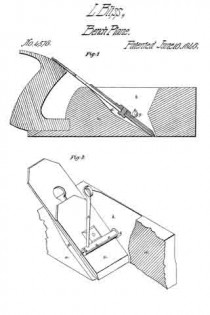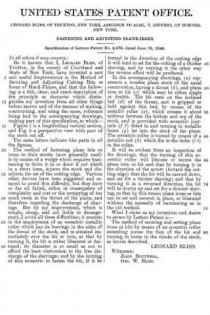
| PLEASE NOTE: The images presented on this page are of low resolution and, as a result, will not print out very well. If you wish to have higher resolution files then you may purchase them for only $2.95 per patent by using the "Buy Now" button below. All purchases are via PayPal. These files have all been cleaned up and digitally enhanced and are therefore suitable for printing, publication or framing. Each zip package contains all the images below (some packages may contain more), and purchased files can be downloaded immediately. |
UNITED STATES PATENT OFFICE.
_________________
LEONARD BLISS, OF TRUXTON, NEW YORK, ASSIGNOR TO SAML. T. JEFFERY, OF HORNER, NEW YORK.
FASTENING AND ADJUSTING PLANE-IRONS.
_________________
Specification of Letters Patent No. 4,576, dated June 16, 1846.
_________________
To all whom it may concern:
Be it known that I, LEONARD BLISS, of Truxton, in the county of Courtland and State of New York, have invented a new and useful Improvement in the Method of Securing and Adjusting Cutting Bits or Irons of Hand-Planes, and that the following is a full, clear, and exact description of the principle or character which distinguishes my invention from all other things before known and of the manner of making, constructing, and using the same, reference being had to the accompanying drawings, making part of this specification, in which —
Figure 1 is a longitudinal vertical section, and Fig. 2 a perspective view with part of the stock cut off. The same letters indicate like parts in all the figures.
The method of fastening plane bits or irons to their stocks (now generally used) is by means of a wedge which requires hammering to drive it in or draw it out which in a short time, injures the stock and dis-adjusts the set of the cutting edge. Various other devices have been suggested and essayed to avoid this difliculty, but they have so far all failed, either in consequence of complexity and cost or the occupying of too much room in the throat of the plane, and therefore impeding the discharge of shavings. But by my improvement, which is simple, cheap, and not liable to derangement, I avoid all these difficulties; it consists in the employment of an eccentric metallic roller which has its bearings in the sides of the throat of the stock, and is situated immediately over the bit or iron, so that by turning it, the bit is either liberated or fastened; its diameter is so small as not to afford the least obstruction to the free discharge of the shavings; and by the turning of this eccentric to fasten the bit, if it be turned in the direction of the cutting edge it will tend to set for the cutting of a thicker shaving, and by turning it the other way the reverse effect will be produced.
In the accompanying drawings, (a) represents a wooden plane stock of the usual construction, having a throat (b), and plane iron or bit (c) which may be either single or double. The bit rests on the inclined bed (d) of the throat, and is gripped or held against this bed, by means of the metallic roller (e), which crosses it about midway between the bottom and top of the stock, and is provided with eccentric journals (f f) fitted to and turning in metallic boxes (g) let into the stock of the plane.
The eccentric roller is turned by means of a metallic rod (h) which fits in the holes (i i) in the roller.
It will be evident from an inspection of the drawings, that the turning of this eccentric roller will liberate or secure the plane iron or bit and that by turning it in the direction of the arrow (toward the cutting edge) that the bit will be carried down, and set for a thicker shaving; and that by turning it in a reversed direction, the bit will be drawn up and set for a thinner shaving, so that by this means plane irons or bits can be set and secured in place, or liberated without the necessity of hammering as in the old method.
What I claim as my invention and desire to secure by Letters Patent is —
The method of securing and setting plane irons or bits by means of an eccentric roller extending across the face of the bit and turning in boxes in the cheeks of the stock, as herein described.
LEONARD BLISS.
Witnesses:
JOHN BOUTWELL,
GEO. W. BLISS.


